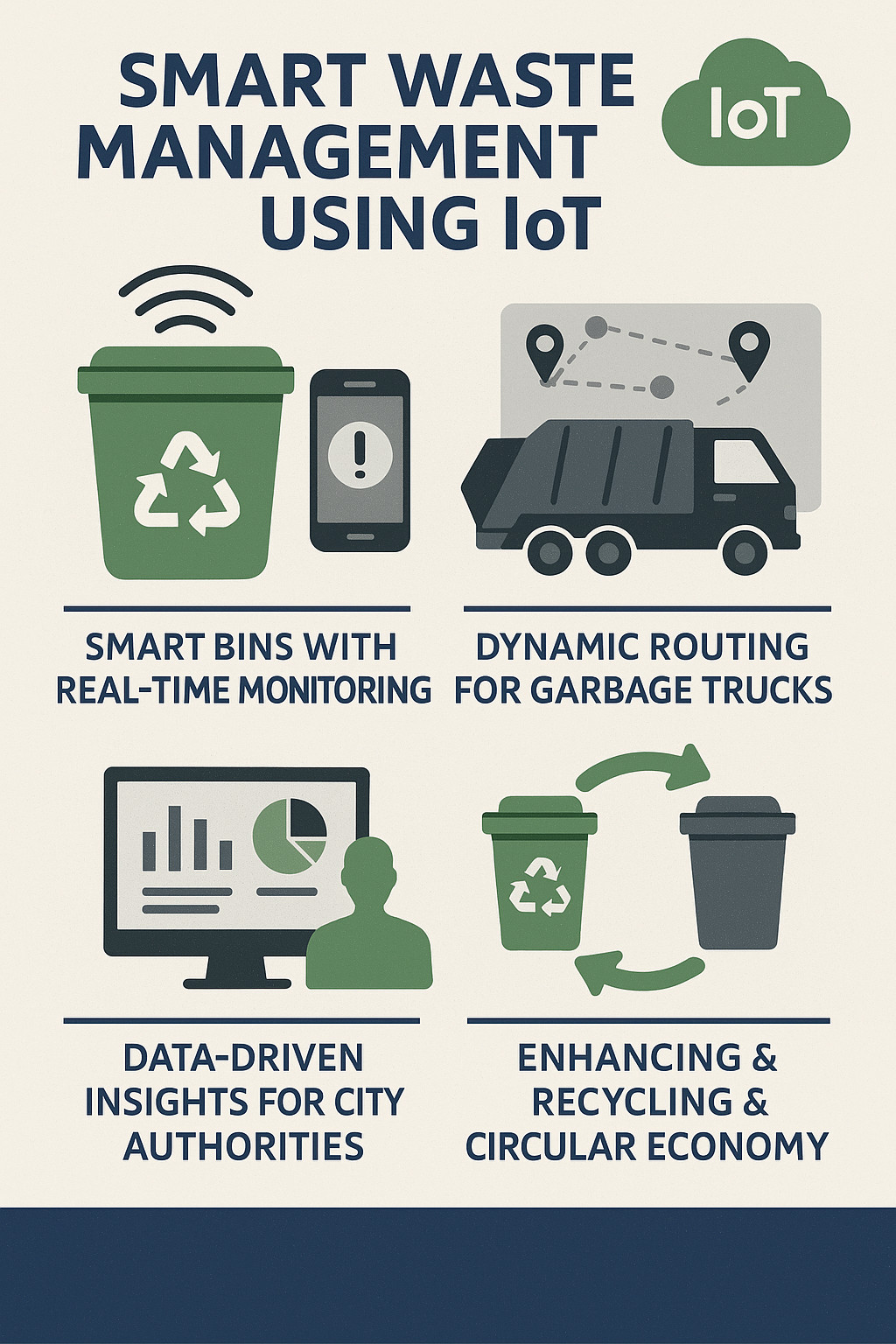Smart Waste Management Using IoT: Revolutionizing Urban Waste Collection
Introduction: The Urban Waste Crisis
As cities around the globe expand rapidly, managing municipal waste has become a critical concern for governments and urban planners. Population growth, urban migration, and limited infrastructure have led to inefficient waste collection processes, overflowing bins, and polluted environments.
Conventional waste management methods are no longer sufficient. Cities need smarter, data-driven systems that can handle increasing waste volumes while ensuring environmental sustainability. This is where the Internet of Things (IoT) comes into play.
What is IoT-Based Waste Management?
IoT-based waste management refers to the use of connected devices, sensors, and software systems to monitor, collect, and manage waste in real time. These smart systems provide continuous data on waste levels, optimize garbage collection routes, and improve recycling efforts — all contributing to a cleaner, more sustainable urban environment.
Why is Smart Waste Management Necessary?
- Rapid Urbanization: More people are moving into cities, increasing daily waste production.
- Overflowing Dumpsters: Traditional systems fail to track which bins need urgent cleaning.
- Resource Inefficiency: Trucks often follow fixed routes, wasting time and fuel.
- Health & Environmental Hazards: Delayed garbage collection leads to unsanitary conditions and pollution.
Key Features of IoT-Enabled Waste Management Systems
1. Smart Bins with Real-Time Monitoring
Smart bins are fitted with ultrasonic or weight sensors that continuously measure how full a dumpster is. When a bin reaches a certain level, it sends a real-time alert to waste management authorities, ensuring immediate action.
These bins can also identify types of waste (wet, dry, recyclable), which helps in waste segregation at the source — a major step toward sustainable recycling.
Keywords: smart bins, real-time waste monitoring, waste segregation IoT
2. Dynamic Routing for Garbage Trucks
With traditional methods, trucks visit each collection point on a fixed schedule — even if bins are empty. This leads to wasted time, fuel, and manpower.
IoT systems solve this through dynamic route optimization. Smart software analyzes bin data and sends trucks only to the locations where pickup is actually needed. This saves fuel, reduces carbon emissions, and cuts operational costs.
Keywords: dynamic routing, garbage collection optimization, IoT waste management system
3. Data-Driven Insights for City Authorities
All data collected from smart bins and IoT devices is stored in centralized cloud systems. Through data analytics and dashboards, city administrators can:
- Track waste generation by area
- Plan bin distribution more effectively
- Identify under-served zones
- Predict future waste patterns
This leads to strategic decision-making based on evidence, rather than guesswork.
Keywords: waste data analytics, IoT city waste tracking, smart waste dashboards
4. Enhancing Recycling & Circular Economy
IoT makes it easier to separate recyclable waste from general trash. Smart bins tagged for recyclable materials can notify trucks for special pickups. This ensures that recyclable items are transported directly to recycling centers, reducing landfill load and supporting a circular economy.
Keywords: IoT recycling, smart waste disposal, circular economy solutions
Use Case: Smart City Waste Management with IoT
Imagine a smart city where:
- Every dumpster is connected and reports fill levels automatically
- Trucks receive optimized routes daily via mobile apps
- Municipal dashboards show which areas generate the most waste
- Recyclables are sorted and picked up separately
- Citizens can report issues using mobile apps linked to the waste system
Such cities already exist — in places like Singapore, Amsterdam, and Barcelona — where IoT in solid waste management has significantly improved efficiency and cleanliness.
Benefits of Using IoT in Waste Management
| Benefit | Description |
|---|---|
| Efficient Collection | Bins are emptied only when needed, preventing overflow |
| Reduced Fuel Consumption | Smart routing minimizes vehicle use and emissions |
| Cost-Effective Operations | Better manpower and fleet management |
| Better Hygiene | Real-time alerts ensure timely garbage disposal |
| Enhanced Recycling Rates | Intelligent segregation supports eco-friendly practices |
| Improved Citizen Experience | Cleaner neighborhoods and reduced complaints |
| Scalable & Customizable Systems | Suitable for both small towns and large metropolitan cities |
Challenges and Solutions in IoT Waste Management
| Challenge | IoT Solution |
|---|---|
| High Initial Investment | Long-term ROI through reduced costs and increased efficiency |
| Network Connectivity in Remote Areas | Use of LPWAN (Low-Power Wide Area Network) or NB-IoT technology |
| Data Security & Privacy | Secure cloud storage and encrypted device communication |
| Integration with Legacy Systems | Custom APIs and middleware solutions for smooth transition |
Future Trends in IoT Waste Management
- AI-Powered Predictive Waste Analysis
- Blockchain for Waste Transaction Tracking
- Citizen Engagement Apps
- Drone Surveillance for Illegal Dumping
- Autonomous Waste Collection Vehicles
Conclusion: Building Cleaner Cities with IoT
IoT in waste management is not just a trend — it’s a sustainable solution to the urban waste crisis. With smart bins, optimized logistics, and real-time analytics, municipalities can drastically improve cleanliness, reduce costs, and protect public health.
As smart city initiatives continue to evolve, integrating IoT into waste management systems will be a crucial step toward creating sustainable, efficient, and eco-friendly urban environments.
See also: Future of IoT in India 2025: Transforming Healthcare, Agriculture, and Smart Cities
If you like this post subscribe our YouTube Channel for IoT video Tutorials.








Leave a Review